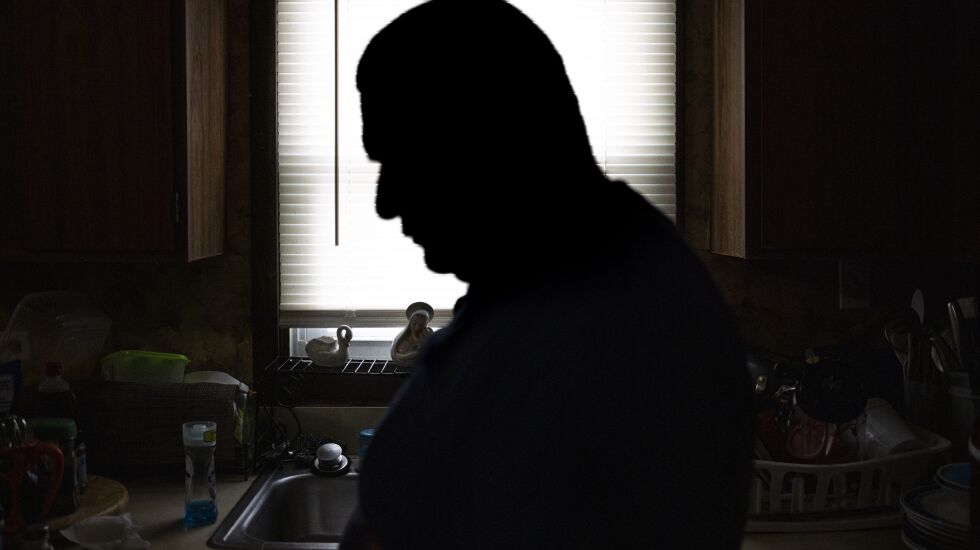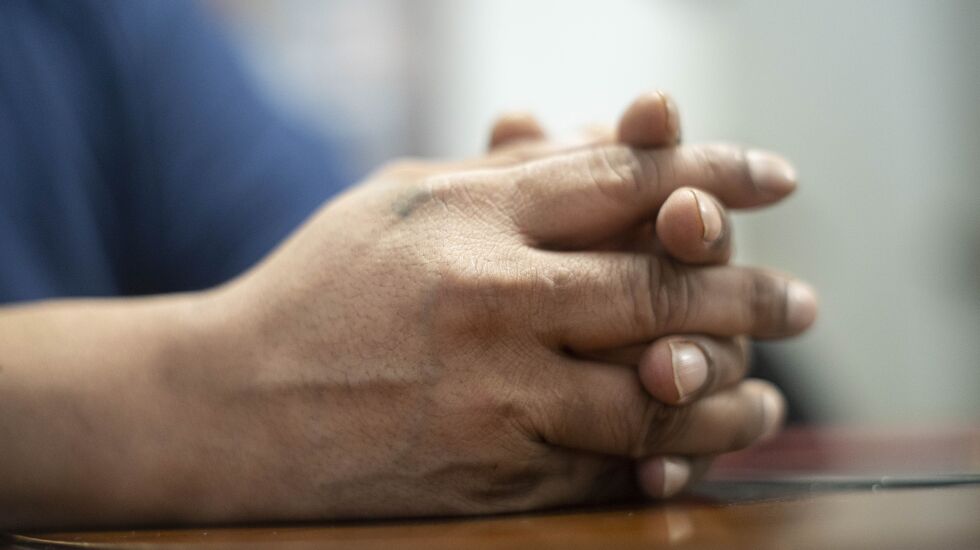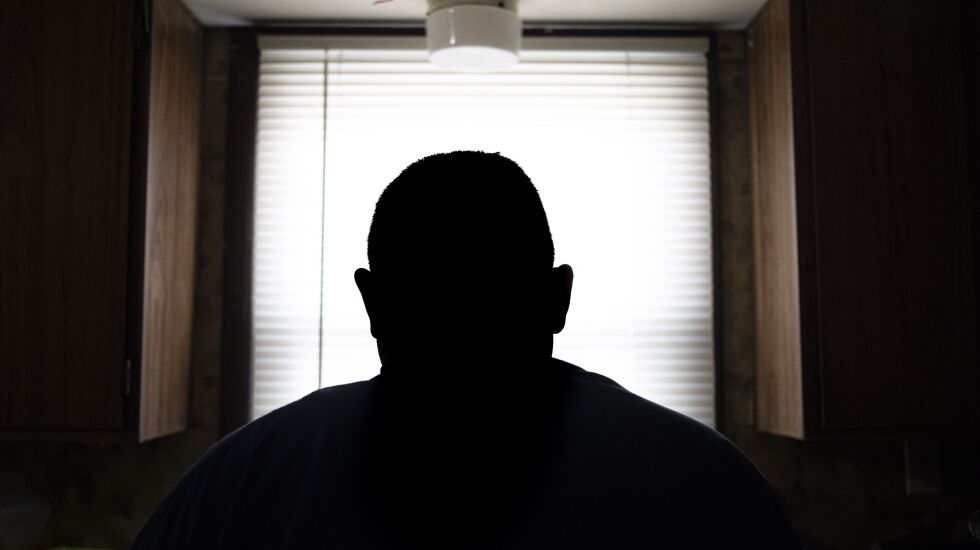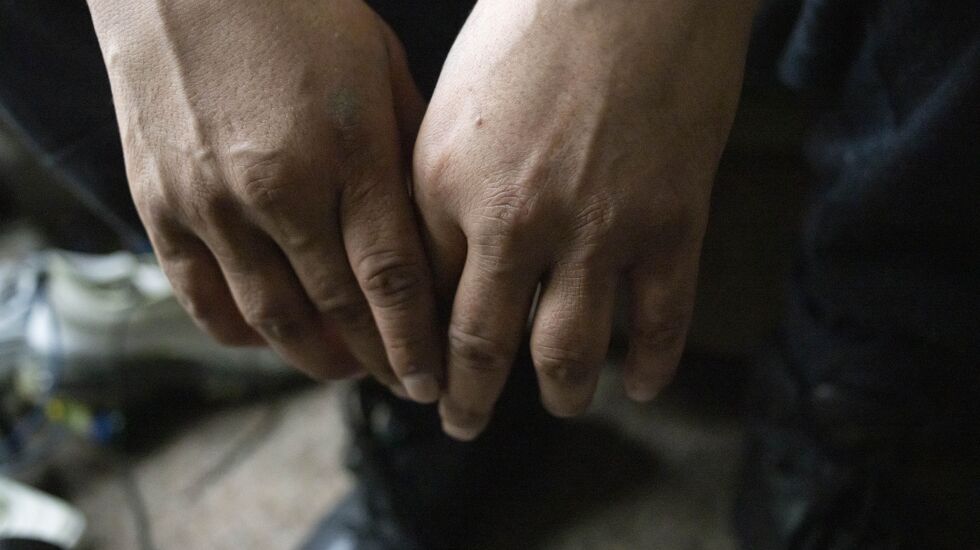
It’s a little after 10 p.m. on a summer night in Chicago.
A man in his 40s who we’re calling Joey is sitting shirtless on a couch in his living room on the city’s West Side. There’s a colostomy bag next to him. He’s covered in tattoos and bandages — each bandage covering an entrance or exit wound from a bullet. A semi-circle of staples runs over his belly, like a frown.
“It happened right there, where the trees are across the street,” Joey said, pointing out his front window.
Joey was shot 11 times. His elderly neighbor who was standing next to him was killed.
For Joey’s safety, WBEZ has changed his name and the name of his family members, and is withholding identifying details about the shooting and where he lives. The shooting has left Joey in debilitating pain, traumatized his children and left them all hiding in their house in fear.

Joey said he knows who shot him; he saw the shooter’s face and recognized him from the neighborhood. He said he intends to cooperate with the police.
“I want the guy in jail. I want justice for [my neighbor] and for me,” Joey said.
But police are moving slowly. Three weeks after the shooting, no arrests have been made, and detectives have not taken Joey’s statement. He said when police visited him shortly after he was released from the hospital, they told him he was too impaired by his pain medicine to make an ID.
In the meantime, Joey and his family are paralyzed by fear.
“They know where I live,” Joey said. “I know they’re going to try it again. I’m not stupid. They’re gonna wait until everything settles, they’re gonna grab me.”
While Chicago’s violence is often defined by the number of people killed, the fact is several thousand people are shot every year in the city and survive. Joey’s saga, reported through months of visits with Joey and his family, shows just how difficult it can be for witnesses to work with a Police Department that claims to be desperate for community cooperation. But it also shows the limits of eyewitness testimony in helping to solve murders.
‘The next target’
The shooting in the summer of 2022 was not Joey’s first run-in with West Side gang violence.
He’d been shot before. And about 20 years ago, a rival gang beat him almost to death and put him in a coma.
His brain was damaged. His personality changed.
“I left the gang when that happened,” Joey said. “I don’t know how to gang bang no more, I don’t know that stuff. God took that away from me.”
While Joey talks, his 14-year-old son, who we are calling Mateo, comes into the room and listens. Mateo just finished eighth-grade.
Mateo said he is spending most of his summer days caring for his father. Like the rest of the family, he is largely confined to the small home.
“I’m worried about walking past [my house], because I’m … probably the next target,” Mateo said.
Cecilia Mannion, a victim advocate with the nonprofit Enlace Chicago, is helping Joey while he recovers. She said she is trying to find emergency funds to relocate the large family.
“It’s really unsafe for him to be here in this location, because they know where he resides,” Mannion said.
‘Long past due’
About a week and a half later, Joey has made enough progress physically he’s able to move from his usual perch in the front room to a chair in the family’s small backyard. Mannion, the victim advocate, visits him to check on his progress.
Joey continues to worry about his safety and said he’s growing more concerned about his son.
“I told him I don’t want you outside. It’s dangerous. This guy knows you my kid; what if he wants to hit you or something?”
Joey won’t feel safe venturing out into the neighborhood until police arrest the man who shot him.
He wants to help them do that. He’s confident he can identify the shooter, but he’s had a really hard time getting detectives to come so he can actually make that ID and give the police a basis for an arrest. He’s heard the detectives have been out on vacation.
“That’s cool, take a vacation because you work hard,” Joey said. “But what about me, man? We got to get this guy before he hurts somebody else.”
Mannion has grown impatient.
“At this point, I think it’s been long past due. They need to come and speak to him already.”
Mannion and Joey decide to call the detective’s office.
A sergeant who answers can’t immediately connect Joey to any detectives who know about the case.
“OK, when you think they’ll come see me?” Joey asks.
The sergeant tells Joey he’s not sure.
“We just got another murder yesterday. So I know they’re working on that one,” the sergeant replies. But he tells Joey at some point, “we’re gonna have you come in, look at a photo array, and then try and see if you can pick this guy out.
Chicago Police Department spokeswoman Margaret Huynh declined to comment on Joey’s case or explain why Joey had such a difficult time getting detectives to come to his house so he could make an ID. She said the department could not comment because it was still an active investigation.

‘It’s him’
After spending four months asking police to come interview him, Joey works up the nerve to leave his house and go down to the police station himself.
At the station Joey meets with an officer who lays out a series of photos on a table. All of them look at least somewhat similar to the man Joey believes permanently wounded him and killed his neighbor.
After some hemming and hawing, Joey fingers a picture he thinks looks the most like the guy. He’s a little worried because the guy he thinks shot him is in his late 30s, and the picture that looks closest to him shows a guy who looks almost 10 years younger than that.
But at the time, he figured, the picture is probably from the last time the guy was arrested.
“It’s like, it’s him. It’s his face. It’s like everything about him,” Joey said.
Joey leaves the station feeling good and steeling himself to testify in the eventual murder trial.
But two days later, a detective calls him and tells Joey he picked out the wrong person.
Joey isn’t sure how police know the guy he picked out is not the one guilty of the crime.
Joey said detectives have told him they have other evidence, and Joey believes there’s still a chance for justice.
He can’t really explain how he picked out the wrong guy after months of insisting he knew who shot him.
“When I [found out I] picked the wrong guy I just put my head down and prayed to God. God is going to take care of it,” Joey said.
‘An abject failure’
Dan Simon, professor of law and psychology at the University of Southern California, said even though Joey ultimately failed the lineup, it was “completely unacceptable” for Chicago police to make him wait so long to make an identification in the shooting.
Simon, who has published frequently on investigations and the legal system, said he feels empathy for Chicago detectives who face daunting time pressures and often uncooperative witnesses. But, he said, in this case, with an eager witness and a fraught situation, the long delay in interviewing Joey was “an abject failure.”
“If you’ve got a … victim who’s begging you to investigate, who’s telling you they’re fearing for their lives, just as a matter of civic duty, you should actually really extend yourself and try to help them out and follow their requests,” Simon said. “Secondarily, as a detective, it’s your own professional interest in investigating as soon as possible.”
Simon said it’s possible the pain medication Joey was taking ultimately hindered his ability to pick the right photo in the lineup, validating police concerns. It’s also possible Joey just doesn’t remember the shooter’s face as well as he thinks he does.
But Simon said it could be the four-month lag between the shooting and the photo lineup hindered Joey’s ability to pick out the right person.
“What happens to memories is that over time they decay,” Simon said. “So what could have happened is that because the lineup was postponed, that was the cause for his failure. And it’s just a simple fact of life that we’re much better at remembering recent things than older things.”

‘I be watching my back’
As the months have worn on without an arrest, 14-year-old Mateo has grown tired of hiding out in the family’s home. He’s started spending more and more time outside despite fears if people learn who his father is they may target him for violence.
“Since I’m outside late I’ll be watching my back,” Mateo said. “Like turning around like every five minutes to see who’s behind me.”
Still, Mateo said he is only “kind of” nervous about being victimized. “But not really, because I’ll be like, with a group of friends.”
That desire to find safety in numbers has Joey and the victim advocate worried that Mateo may follow the path his father, and so many other young men, have taken into gangs and a world of violence.







